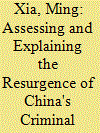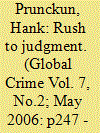| Srl | Item |
| 1 |
ID:
075701


|
|
|
|
|
| Publication |
2006.
|
| Summary/Abstract |
Based upon collected crime statistics, this paper provides a sketch of China's criminal underworld during the past two decades and a quantitative assessment of its current state. Through examining the organised criminal groups, it also assesses the hardcore of China's criminal underworld — the mafia-style criminal syndicates and their greater base — the underworld society. It argues that a challenge from the criminal underworld has increasingly posed a serious threat to Chinese society. It also provides explanations for the recent resurgence of the criminal underworld in China through a perspective of political science — placing emphasis on the state-failure factors.
|
|
|
|
|
|
|
|
|
|
|
|
|
|
|
|
| 2 |
ID:
075704


|
|
|
|
|
| Publication |
2006.
|
| Summary/Abstract |
Within Albania and China and their respective diasporas, a history of extreme violence, both official and unofficial, is widely accepted but not easily understood from a Western perspective. Over the course of centuries both societies have experienced turmoil and in the 20th century spent decades under the disastrous communist dictatorships of Enver Hohxa (1944-1985) and Mao Zedong (1949-1976). Acts of organised/collective violence should be interpreted in their historical and cultural contexts. As both Albania and China underwent considerable internecine feuding, and all manners of deprivations and oppressions under the governance and proclamations of their various rulers, it may not be surprising that their subjects became inured to violence. Violence is neither meaningless nor peculiar to China/Albania. One explanation arises from the continuing purchase of ancient codes of 'extreme violence'. This paper describes two ancient instruments justifying 'excessive violence' that have continued to exist even today and directly link them to the violent behaviour of contemporary Albanian and Chinese organised crime groups. The paper will explore the historico-cultural origins of Albanian and Chinese organised crime and their recent reputation as 'ultra-violent' actors. Specifically we examine the 15th century Albanian legal code known as the Kanun of Lek Dukagjini, and the 17th century code of the Chinese Hung Mun (Triad Society).
|
|
|
|
|
|
|
|
|
|
|
|
|
|
|
|
| 3 |
ID:
075702


|
|
|
|
|
| Publication |
2006.
|
| Summary/Abstract |
This paper aims to identify the variables that contribute to explain the current ability of the Colombian criminal system to resolve cases of kidnapping, terrorism and embezzlement. In order to achieve this goal a sample of cold cases and sentenced files were analysed in three main cities of the country. The success of a criminal investigation was divided into three stages: a) the identification of at least one suspect per case; b) the accusation and putting on trial of the suspect; and c) his/her conviction. Econometric techniques were used to identify the criminal investigation variables associated to each of the three successes. Variables such as the evidence and investigative practices used by the judicial police, the attorneys and the courts were taken into account. The results of this study have important implications for criminal investigation and crime policy in Colombia and in the region.
|
|
|
|
|
|
|
|
|
|
|
|
|
|
|
|
| 4 |
ID:
075703


|
|
|
|
|
| Publication |
2006.
|
| Summary/Abstract |
There have been several studies conducted about racist groups, gangs, cults, terrorist and other criminal organisations, but very little has been written about the psychology and recruitment process of the 'narcotrafficker'. This is because like most criminal organisations, they tend to be secretive and difficult to penetrate by law enforcement, academics and others who wish to study them. Using an audio?recorded content analysis of 'narcocorridos' - ballads glorifying the activities of the 'narcos' and describing their successes' - as well as Social Identity and Group theories, the author describes some of the techniques used to recruit individuals into drug cartels; the labels, stereotypes and images of the in-group versus the out-group and the similarities in the socialisation and recruitment process of other criminal organisations. This study shows the recruitment of individuals into drug cartels follow similar patterns to other criminal organisations including the need for power, belonging, respect, security and pride.
|
|
|
|
|
|
|
|
|
|
|
|
|
|
|
|
| 5 |
ID:
075705


|
|
|
|
|
| Publication |
2006.
|
| Summary/Abstract |
This paper reassesses the origins of what has been referred to as the Australian "heroin drought." It looks at the theories that circulated in drug policy circles immediately after the supply shortage was discovered in 2001. It concludes that there may have been a "rush to judgment" as these inferences were based on unsatisfactory data. As such, none of the theories that were advanced at the time hold true - the shortage was almost certain to have been the result of a Taliban- enforced reduction of Afghanistan grown opium. As interdiction strategies were one of the main theories for the shortage, this might seem disappointing, especially as supply reduction strategies struggle to maintain relevancy against a growing shift to demand reduction and harm reduction strategies. But this situation should not be the case - drug seizures should not be hailed as law enforcement's central strength in this or any other situation. Instead, the strong point of policing should be seen as the broad approach it takes to reduce crime through its attack on all criminal enterprises, not just its assault on a particular criminal sector - like the drug trade
|
|
|
|
|
|
|
|
|
|
|
|
|
|
|
|